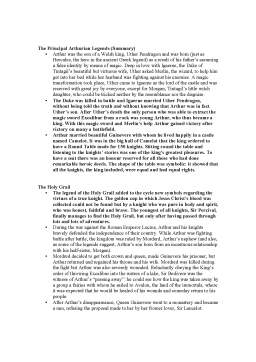Extras din proiect
Middle English Prose and Poetry
- Middle English prose of the 13th century continued the tradition of Anglo-Saxon prose – didactic and directed toward ordinary people rather than aristocratic society.
- The fact that there was no French prose tradition was very important to the preservation of the English prose tradition, formed with the help of the story-tellers and historians.
- Poetry took a lyrical turn under the impact of French sources.
- Several poems in early Middle English were preserved, offering samples of language, philosophical thought and artistic force.
- The Orrmulum (c. 1200), a verse translation of parts of the Gospels, is of linguistic (mainly phonological) and prosodic rather than literary interest. This collection of homilies was written by Orrm (or Orrmin), an Augustinian monk of Lincolnshire, hence the name of the work.
The Owl and the Nightingale
- Of approximately the same date, The Owl and the Nightingale is the first example in English of the debat, a popular continental form. In the poem, the sober owl, representing monastic and didactic ideas, and the merry nightingale, a free secular spirit, debate the virtues of their ways of life. The allegory may represent the argument between asceticism and pleasure, philosophy and art, or the older didactic poetry and the newer secular love poetry. The poem can be regarded both as an allegory and a bestiary, specific forms illustrative for medieval literature.
The Medieval Romance
- In the 13th century the romance, an important continental narrative verse form, was introduced in England. It drew from three rich sources of character and adventure:
- the legends of Charlemagne (the matter of France);
- the legends of Greece and Rome (the matter of Troy and the matter of Rome);
- the British legends of King Arthur and the Knights of the Round Table (the matter of Britain).
Layamon’s “BRUT”
- Layamon’s Brut, a late 13th century metrical romance translated from French marks the first appearance of Arthurian matter in English. Original English romances based upon indigenous material include King Horn and Havelok the Dane, both 13th century works that retain elements of Anglo-Saxon heroic tradition.
- The Brut is 16,095 lines long and narrates the history of Britain. It is largely based on the Anglo-Norman Roman de Brut by Wace, which is in turn inspired by Geoffrey of Monmouth's Historia Regum Britanniae, though is longer than both and includes an enlarged section on the life and exploits of King Arthur. The rhyming style is the alliterative verse line style commonly used in Middle English poetry.
New Values and Tastes
- French romances were easily accepted even on British soil, as they popularized ideas of adventure and heroism based upon new values and tastes. New manners and rituals, the idea of courtly love replaced some of the principles of the old heroic code.
- The "lovesick" knight became a conventional figure in medieval romance. Typical symptoms: sighing, turning pale, turning red, fever, inability to sleep.
THE CHIVALRY ROMANCES
- We generally define chivalry as a system of ethical ideals that arose from feudalism and had its highest development in the 12th and 13th centuries. Chivalric ethics originated mainly in France and Spain but spread rapidly to the rest of the Continent and England. Young noblemen were taught from early childhood the principles of both Christian and military morality and conduct. Piety, honour, valour, courtesy, chastity and loyalty were the chief chivalric virtues.
L’Amour Courtois
- The romance of chivalry had a great importance in those days. New ideals of life were expressed in such literary creations, in which the brave knights fought for honour and dignity, for a noble life, for a well-respected and beloved lady. Love, in the chivalrous sense, was largely platonic; it was the so-called amour courtois (courtly love), the object of which could be only a virgin or another man’s wife. In the romances the knight tended to appear as the embodiment of all human virtues, even if in real life chivalric conduct was never free from corruption.
- The ideal of militant knighthood was greatly promoted by the Crusades and the monastic orders of knighthood (The Knights Templars and the Knights Hospitalers). The virtues of the knights could be proved either on battlefield or in tournaments, according to the complicated code of conduct imposed at court.
Preview document
Conținut arhivă zip
- Medieval Literature in Britain - The Chivalry Romances.doc







